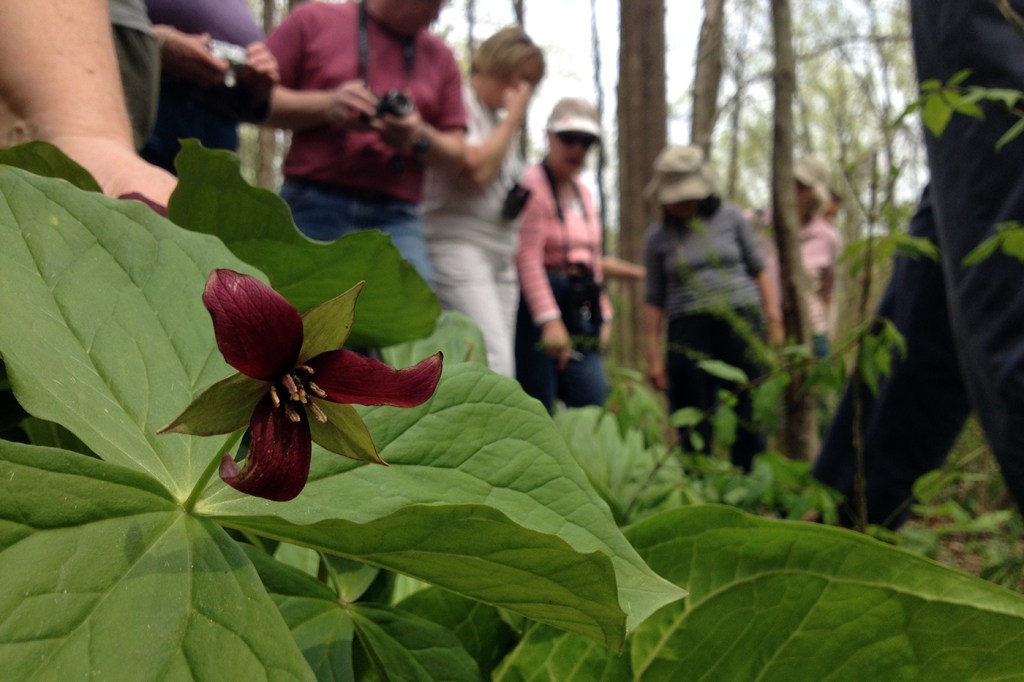What are crowdsourced photos taken along hiking trails telling us about the climate?

The Pacific Crest Trail, a 2,650-mile route that stretches through California, Oregon and Washington, is fraught with the effects of climate change. Hundreds of miles of trails have been closed in recent years due to wildfires, and heavy rains threaten to erode trails and fell trees.
Could trails on the other side of the country meet a similar fate? The impact of climate change on New England trails may be more subtle, but they’re there, says recent Northeastern graduate Graceanne Piselli. As part of her work for the U.S. National Parks Service, she helps to identify the signs, thanks to thousands of crowdsourced photos of wild plants.
“If climate change is impacting the trails, it’s largely impacting them by the diversity of plants along the trail and how those plants are surviving,” Piselli says. “We’re seeing if the stages of their life cycles are happening on time, or if warmer temperatures are causing spring to come earlier, or if it’s coming later.”
Piselli, who graduated in May with a bachelor’s degree in ecology and evolutionary biology, is no stranger to looking at how climate change impacts outdoor spaces. As an undergraduate, she did her co-op at Northeastern’s Marine Science Center, where she worked in the outreach department and did her capstone project on how climate change is impacting, and will continue to impact, the multi-billion-dollar ski industry in North America and Europe.

“I found that there is going to be significant reductions in how long they can operate,” she says. Soon, climate change will reduce the number of skiable days in the year, she says, thereby reducing the length of the ski season. At the same time, she says, ski slope managers don’t seem to grasp the risk of climate change to their businesses.
Now, she’s shifted her focus to another outdoor activity: hiking.
As an intern at the New England Trail, Piselli analyzes crowdsourced data on flowering plants along the New England National Scenic Trail. The trail, which was designated in 2009, cuts through the middle of Connecticut and Massachusetts, stopping at the border with New Hampshire, and is about 215 miles long. According to the trail website, it crosses through a variety of ecosystems, and features waterfalls, mountain ridges, glades, vernal pools and more. It’s also home to countless species of wild plants.
That’s where iNaturalist comes in. The website and app, which has over 2 million users, allows hikers to upload photos of plants and animals in their natural environment, and collaborate to help identify the plant or animal and discuss what they’ve found.
But it’s more than a social network; the photos submitted to iNaturalist also provide data to researchers looking to chart the biodiversity of any given area. For Piselli, it’s an invaluable data source, and one that she’s done her part to expand. Over the course of this spring, she set up tables at different trailheads—from Meriden and Berlin, Connecticut, to Holyoke and Northampton, Massachusetts, four of the most popular trailheads—to promote the project, telling hikers to take pictures on their treks and upload them to the app.
The results reveal the breadth of diversity along the different parts of the trail. On June 5 in Higganum, Connecticut, an iNaturalist user found mapleleaf viburnum along the trail; on the same day in Granby, Massachusetts, a hiker discovered four-leaved milkweed; in Amherst, Massachustts, someone submitted a picture of yellow star grass.
From there, it’s up to Piselli to sort through the data and create an accurate biodiversity survey of the space. Geotagging helps Piselli make sure she doesn’t have duplicates, though there are no guarantees—she still sometimes gets two photos of the same plant taken by two different people. Each person contributes three photos on average, though two people have contributed 250 observations each, forming 14% of her total database.
Based on the photos, she then determines which plants are in bloom at any given time, discovering baseline trends in plant life. We know, for example, that red trillium and painted trillium flower early in the spring, and that red columbine flowers bloom late.
Now, using 10 years of data and 3,200 observations, Piselli is able to show that three more plants consistently bloom around the same time: the yellow trout lily blooms in early spring, the Jack-in-the-pulpit blooms in mid-spring, and the Canada mayflower blooms late. In her final report, which she’ll present to the Appalachian Mountain Club and the National Park Service, she will present this data showing these plants as baselines for whether a temperature threshold has been reached for spring, and illustrate how these indicator species are impacted by changing temperature, elevation or other factors which can be influenced by climate change.
Her data isn’t wide-ranging enough to show the impact of climate change, but it does form a useful standard for the future. For example, if the yellow trout lily starts to bloom in late spring, “then we know that there’s a significant temperature difference going on,” she says. Alternatively, if we start to see plants flowering earlier than they should, “that means that things are warming up quicker,” she says.
After turning in the report, Piselli will resume her work as an educator at the Mystic Aquarium in Connecticut, and will start looking for another ecology internship for spring and summer. She might go to graduate school in the fall.
The impact of her internship has been stronger than just the data. It also “really gave me an opportunity to explore my own backyard a little bit,” she says, and she was happy to connect with hikers over their shared love of nature. Not surprisingly, she found, the hikers cared deeply about preserving the outdoor space.
For media inquiries, please contact media@northeastern.edu.






